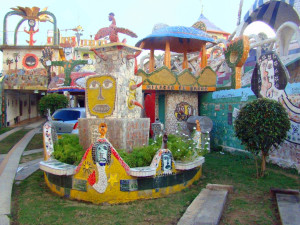Fusterlandia is situated in the seaside village of Jaimanitas, a western suburb of Havana. The exteriors of about 80 homes are covered from top to bottom with brightly colored tiles forming whimsical images, from exotic people, plants and animals to unusual takes on famous paintings. Outside the houses are statues, some standing ten or more feet tall, also covered with mosaics. Some of the art work is primitive, some evokes Picasso and some is quite realistic. Images from Santeria and Cuban folk tales are particularly popular.
This vibrant art all comes from the hands and mind of Jose Fuster, after whom the area is affectionately named. Fuster was born in Cuba in 1946 and worked as a literacy tutor in the Sierra Maestra Mountains at age 14 before being trained as an artist in Havana. He has exhibited his paintings and ceramics in several countries, including the United States, and began creating Fusterlandia thirty years ago.
Fuster often holds court in the studio in his small house, above a courtyard overflowing with art. Over a glass of rum, he gladly shares his artistic and political views. He says he decorated the neighborhood to help his impoverished neighbors. That is certainly part of the story. In addition, Fusterlandia attracts hundreds of foreign visitors to Fuster’s studio every year, where they can purchase art items selling for up to $10,000. Art is exempt from the U.S. trade embargo and Fuster is now allowed to keep the proceeds of his sales, subject to paying a fifty percent tax on his profits. His son recently quit his job as a government physician earning about 40 dollars a month to work full-time for his father.
For visitors to Havana, Fusterlandia is an oasis of color and free enterprise in a country still short of both. It is also an example of the changes that are happening in the Cuban economy.
